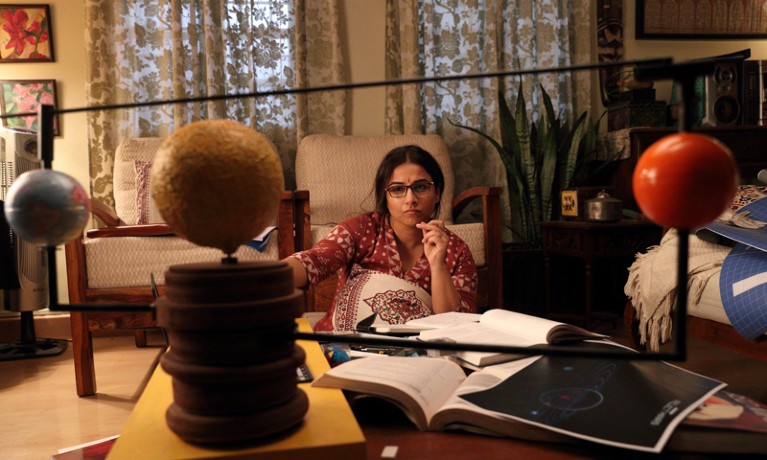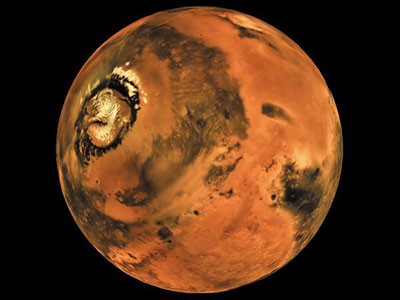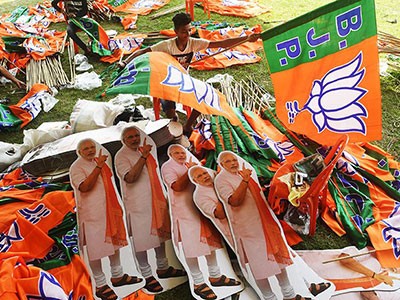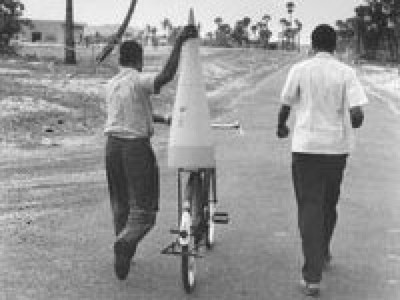
Vidya Balan plays Tara Shinde, project director for India’s Mars Orbiter Mission, in Mission Mangal.Credit: Sterling Media
Mission Mangal Director: Jagan Shakti Cape of Good Films/Hope/Fox Star Studios (2019)
In 2013, India reached for Mars. Its first interplanetary mission, dubbed Mangalyaan (officially the Mars Orbiter Mission, or MOM), launched a probe carrying five instruments to study aspects of the red planet, from its mineral composition to potential signs of past life. Now, a fictional treatment on film by first-time director Jagan Shakti celebrates the scientists who got MOM off the ground.
Released on 15 August — India’s independence day — Mission Mangal fictionalizes the tense months from approval to launch, a race to lift off when Mars would be closest to Earth. It is very much a homage to the Indian Space Research Organisation (ISRO) and the country’s technological prowess, and as such stirs up national pride. But the film is also successful scientific storytelling, performed by a glittering cast.
Five millennia of Indian science
Science communication can be notoriously tricky, treading a line between oversimplification of concepts and overuse of jargon. Mission Mangal avoids the latter, but some sections have been accused of dumbing down highly technical ideas. One scene drew widespread criticism at the trailer’s launch in July. MOM project director Tara Shinde (played by the supremely talented Vidya Balan) is shown making puris, deep-fried rounds of Indian bread. After she turns the stove off to save gas, the oil remains on the boil for some time. She then realizes that a similar technique would allow ‘smart’ space vehicles to stay in orbit: the fuel could be switched off to make use of Earth’s gravitational pull. As I watched this supposedly divisive scene, a woman sitting beside me nodded approvingly. The principle of economy in space had hit home.
It’s a key point: judicious use of resources is an ISRO speciality. The organization boasts the world’s cheapest solutions for space missions. They range from the compact Small Satellite Launch Vehicle to space-saving satellites such as the Microsat, which weighs about 100 kilograms and can latch on to any space mission as a co-payload. Mission Mangal emphasizes how stripped-back ISRO labs and tight budgets encourage innovation.
Frugal efficiency
After MOM launched, Prime Minister Narendra Modi commented that at just 4.5 billion rupees (US$74 million), it cost less than Alfonso Cuarón’s 2013 film Gravity. In fact, starting with physicist Vikram Sarabhai and aerospace engineer Satish Dhawan in the 1960s and 1970s, Indian scientists paving the way to a national space programme have practised ‘frugal efficiency’.
Mission Mangal is framed by an apparent setback. This is the moment in 2010 when a test of ISRO’s Geosynchronous Satellite Launch Vehicle was aborted just over a minute after lift-off, after scientists detected snapped communication connectors. The film recounts how lead scientists Shinde and Rakesh Dhawan (Akshay Kumar) plan a relaunch, but are politely shunted to ISRO’s unglamorous, underfunded Mars section.
Science and the rise of nationalism in India
Here, they begin to work their magic as they pull together and train their team. NASA, inevitably, is a recurrent theme. The Indian-born, NASA-trained scientist Rupert Desai (Dalip Tahil) helms ISRO’s prestigious Moon mission, Chandrayaan. The young Eka Gandhi (Sonakshi Sinha) wants to use ISRO as a stepping stone to the US space agency. There are glimpses, too, of the personal lives of scientists beyond lab and launch site, breaking down tedious stereotypes in the process. One scene shows the mission’s female scientists dressed in bright saris — just as they were in a memorable 2014 photo showcasing ISRO’s womanpower.
The technological jockeying for position common among space-faring nations is also captured. Mission Mangal alludes to a cartoon published in The New York Times in 2014, of a turbaned man leading a cow knocking at the door of a building marked ‘Elite Space Club’. It was widely criticized as racist, and the paper apologized. Three years later, after India launched a record 104 satellites on one craft, The Times of India published a cartoon showing India inside the club as other countries seek entry.
The coming decade is set to see some of India’s major space ambitions take wing. The Department of Space got an 11% budget hike for 2019–20, and ISRO is set to launch its first crewed mission, Gaganyaan, before the 75th anniversary of India’s independence, in 2022. And, in a fitting 50th-anniversary tribute to Apollo 11, India’s second mission to the Moon, Chandrayaan-2, set a course for the uncharted lunar south pole in July. As Nature went to press, the Vikram lander was due to touch down on 7 September.
Amid vast global challenges and the emergence of space-flight entrepreneurs, India’s space innovation continues apace. Mission Mangal’s focus on the dedicated, visionary researchers behind ISRO’s Mars mission reminds us how doing science that is of use to society demands an inner fire.


 Science and the rise of nationalism in India
Science and the rise of nationalism in India
 Five millennia of Indian science
Five millennia of Indian science
 Built by bicycle
Built by bicycle







